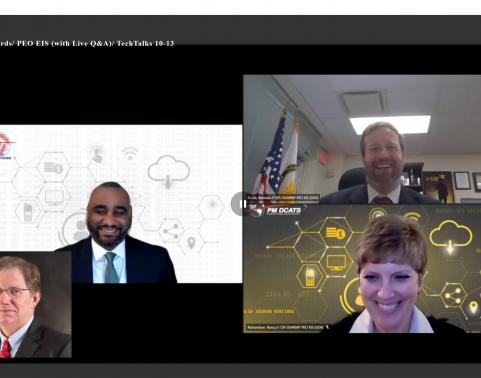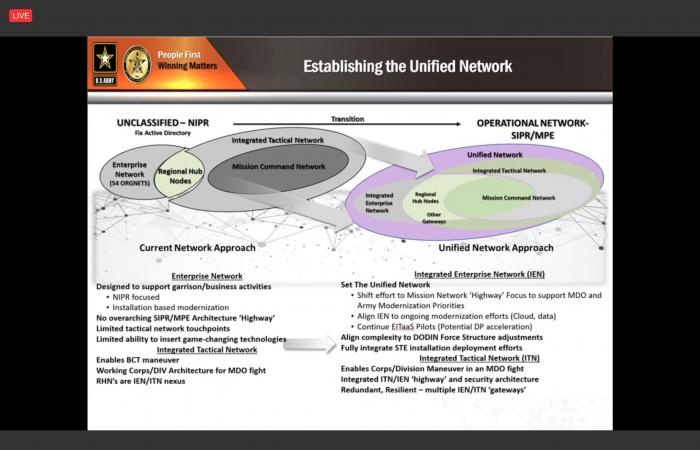PEO EIS panel discusses Army’s unified network, industry opportunities

A panel of leaders from PEO EIS held a discussion on “Integrated Enterprise Network Modernization” April 21 as part of AFCEA’s TechNet Augusta Virtual Solution Series.
Moderated by John Howell, assistant program executive officer for networks, cyber and services at PEO EIS, the panel focused on how several network-oriented project offices will support the Army deputy chief of staff, G-6’s strategy of converging the Army’s integrated tactical and enterprise networks.
Harkening back to Lt. Gen. John Morrison’s remarks from the previous day, PEO EIS’s deputy program executive officer Brendan Burke said the Army is focused on removing artificial barriers between the enterprise and tactical networks. “There needs to be no seam between tactical and enterprise; the tactical users need to be able to reach back to the enterprise, and the enterprise has got to be able to support that tactical mission,” said Burke.
Displaying a chart on how the Army plans to establish the unified network, Howell said PEO EIS’s charter is to support the G-6 and work in coordination with numerous stakeholders to achieve a more effective operational network, both on the classified and unclassified sides. To do this, EIS will need to help build out the integrated security architecture, including by enabling zero trust and enterprise identity, credential and access management.
The Army wants to allow Soldiers on the battlefield to “reach back and take advantage of resources on the enterprise network,” said Howell, citing the cloud, artificial intelligence and machine learning as examples of such resources.
Howell went on to mention that EIS’s ongoing pilot of Enterprise IT as a Service (EITaaS) will help inform how the Army modernizes post camps and stations, as well as how it potentially does network convergence.
“Bottom line is that [EITaaS] is a pilot; it will remain a pilot in accordance with the acquisition schedule,” he added.
Nancy Richardson, deputy project manager for PEO EIS’s Defense Communications and Army Transmission Systems (DCATS) project office, described the challenge of achieving the unified network.
“Given the sheer size and scope of the enterprise network for the Army, consisting of some 288 post camps and stations worldwide, we’re really challenged all the time to find ways to balance ensuring we’re getting the latest technologies out to our user base and doing so in a manner that’s cost-effective and sustainable for our partners,” she said.
By forecasting, conducting technology refreshes in cycles and standardizing on particular solutions for a period of time, DCATS is able to address these challenges, said Richardson.
Lee James, project manager for PEO EIS’s Enterprise Services project office, told industry attendees about an upcoming business opportunity within his portfolio. In response to a question about the Army Enterprise Staff Management System contract, James said that the request for proposals will be released in the fourth quarter of 2021.
“We’ll be working two tasks. One, we’ll select a SaaS [software as a service] offering or tool … and two, we’ll select a managed service provider,” said James.
Wrapping up the industry panel, Burke encouraged attendees to use PEO EIS’s online meeting request form to contact the product offices within each portfolio.
“Make sure when you come to see us, you understand how your solution would fit into the larger enterprise,” said Burke. “We want to be innovative, but it can’t be innovative for innovation’s sake. It’s got to be sustainable and fit within the unified network,” he added.
Related News
-
Onedia James: a logistician and leader with a family legacy of service
April 22, 2025Onedia James recently stepped into the role of acting deputy project manager for Army Data and Analytics Platforms (ARDAP) at U.S. Army Program Executive Office (PEO) Enterprise, where she helps oversee and support the data portfolio’s four programs. -
PEO Enterprise’s new PL Digital Market reimagines IT product/service procurement
April 2, 2025FORT BELVOIR, Va. – U.S. Army Program Executive Office (PEO) Enterprise today announced the launch of the Product Lead (PL) Digital Market, which replaces PL Computer Hardware, Enterprise Software and Services (CHESS), effective Apr. 2, 2025. -
Two vastly different Army programs prepare for Software Acquisition Pathway
March 24, 2025At U.S. Army Program Executive Office Enterprise, which is now over two years into its Agile transformation, several enterprise software programs are already in the execution phase of the DOD’s Software Acquisition Pathway, which is designed to facilitate rapid and iterative delivery of software capability to users.
Work for Us
Join a winning team! Search for job opportunities with PEO Enterprise.
Work with Us
Help support important missions. Explore ways your company can work with PEO Enterprise.
